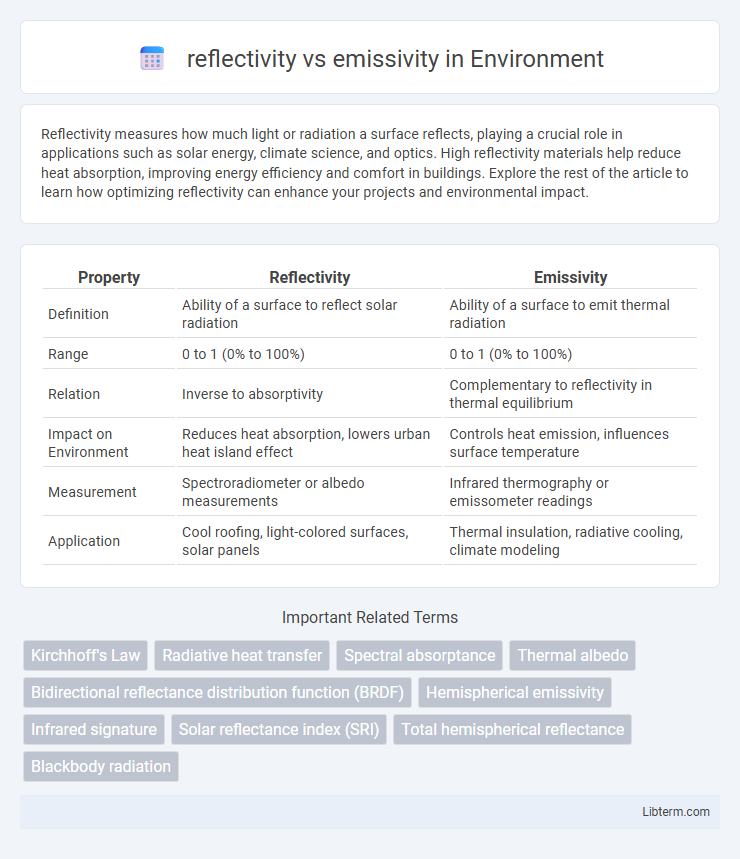Reflectivity measures how much light or radiation a surface reflects, playing a crucial role in applications such as solar energy, climate science, and optics. High reflectivity materials help reduce heat absorption, improving energy efficiency and comfort in buildings. Explore the rest of the article to learn how optimizing reflectivity can enhance your projects and environmental impact.
Table of Comparison
| Property | Reflectivity | Emissivity |
|---|---|---|
| Definition | Ability of a surface to reflect solar radiation | Ability of a surface to emit thermal radiation |
| Range | 0 to 1 (0% to 100%) | 0 to 1 (0% to 100%) |
| Relation | Inverse to absorptivity | Complementary to reflectivity in thermal equilibrium |
| Impact on Environment | Reduces heat absorption, lowers urban heat island effect | Controls heat emission, influences surface temperature |
| Measurement | Spectroradiometer or albedo measurements | Infrared thermography or emissometer readings |
| Application | Cool roofing, light-colored surfaces, solar panels | Thermal insulation, radiative cooling, climate modeling |
Understanding Reflectivity: Definition and Principles
Reflectivity measures the fraction of incident electromagnetic radiation reflected by a surface, directly influencing energy retention and thermal management. It varies with material properties and wavelength, playing a critical role in applications like solar panel efficiency and building insulation. Understanding reflectivity involves analyzing surface texture and optical properties to optimize energy reflection and reduce heat absorption.
Emissivity Explained: Key Concepts
Emissivity measures a material's ability to emit thermal radiation compared to a perfect blackbody, with values ranging from 0 to 1, where 1 represents complete emission. Reflectivity is the fraction of incident radiation reflected by a surface, typically inversely related to emissivity for opaque materials, following Kirchhoff's law of thermal radiation. Understanding emissivity is crucial for accurate temperature measurements in infrared thermography and thermal imaging applications.
The Physics Behind Reflectivity and Emissivity
Reflectivity measures the fraction of incident electromagnetic radiation reflected by a surface, while emissivity quantifies a material's efficiency in emitting thermal radiation relative to a perfect blackbody. According to Kirchhoff's law of thermal radiation, at thermal equilibrium, a surface's emissivity is equal to its absorptivity, which is inversely related to its reflectivity, since energy conservation dictates that the sum of reflectivity, absorptivity, and transmissivity equals unity. These interrelated properties govern heat exchange processes and are critical in applications such as thermal insulation, radiative cooling, and climate modeling.
How Reflectivity and Emissivity Differ
Reflectivity measures the fraction of incident radiation a surface reflects, while emissivity quantifies a material's ability to emit thermal radiation compared to a perfect blackbody. High reflectivity surfaces typically have low emissivity, as they reflect most energy instead of emitting it. These properties influence energy balance and heat transfer in applications like building insulation, solar panels, and thermal imaging.
Relationship Between Reflectivity, Emissivity, and Absorptivity
Reflectivity, emissivity, and absorptivity are interrelated properties that describe a material's interaction with radiation. According to Kirchhoff's law of thermal radiation, emissivity equals absorptivity at thermal equilibrium, meaning a material that efficiently absorbs radiation also emits it efficiently, while reflectivity complements absorptivity such that the sum of reflectivity and absorptivity equals one for opaque surfaces. Understanding this relationship is crucial for applications in thermal insulation, energy-efficient building materials, and radiative heat transfer analysis.
Real-World Examples: High Reflectivity vs. High Emissivity Materials
High reflectivity materials, such as aluminum and silver, are commonly used in thermal insulation and reflective coatings for buildings to reduce heat absorption by reflecting a significant portion of solar radiation. Conversely, high emissivity materials like black steel and oxidized metals efficiently radiate absorbed heat, making them ideal for heat dissipation in radiators and solar thermal collectors. The balance between reflectivity and emissivity directly impacts energy efficiency in applications ranging from passive cooling systems to industrial heat management.
Practical Applications in Building and Construction
High reflectivity materials, such as white roofing membranes, reduce heat absorption by reflecting solar radiation, leading to lower cooling costs in buildings. Emissivity plays a crucial role in the thermal performance of building envelopes by enabling surfaces to efficiently emit absorbed heat, which helps regulate indoor temperatures. Combining low emissivity coatings with reflective surfaces optimizes energy efficiency in windows and walls, essential for sustainable construction.
Impact on Energy Efficiency and Thermal Management
Reflectivity and emissivity directly influence energy efficiency and thermal management in building materials and coatings. High reflectivity reduces heat absorption by reflecting solar radiation, thereby lowering cooling loads and energy consumption, while high emissivity enhances thermal radiation emission, facilitating heat dissipation and improving passive cooling. Optimizing the balance between these properties in construction and industrial applications leads to improved temperature regulation, reduced HVAC demands, and enhanced overall energy savings.
Measurement Techniques for Reflectivity and Emissivity
Measurement techniques for reflectivity often involve using spectrophotometers or gonioreflectometers to quantify the ratio of reflected to incident radiation across specific wavelengths. Emissivity measurements typically employ devices such as emissometers or infrared thermography, which capture emitted thermal radiation and correlate it with surface temperature to determine emissive properties. Accurate calibration against known standards and controlling environmental conditions are critical for both techniques to ensure precise and reliable data.
Selecting Materials: Balancing Reflectivity and Emissivity
Selecting materials requires balancing reflectivity and emissivity to optimize thermal performance and energy efficiency. High reflectivity materials, such as aluminum and silver coatings, effectively reduce heat gain by reflecting solar radiation, while materials with high emissivity, like oxidized metals or specialized ceramics, excel at radiating absorbed heat away. Engineering applications demand a strategic choice between these properties to enhance insulation, minimize cooling loads, and ensure durability under specific environmental conditions.
reflectivity Infographic

 libterm.com
libterm.com